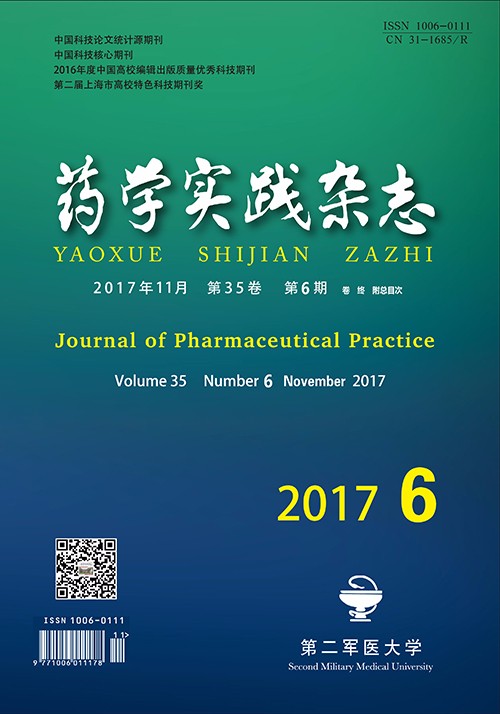LI Yanping, SUN Zhouliang, LIN Weiwei. Practice of pharmacy consultation on dosage regimen for pediatric epilepsy patient with PPK model[J]. Journal of Pharmaceutical Practice and Service, 2017, 35(6): 559-561. doi: 10.3969/j.issn.1006-0111.2017.06.019
| Citation:
|
LI Yanping, SUN Zhouliang, LIN Weiwei. Practice of pharmacy consultation on dosage regimen for pediatric epilepsy patient with PPK model[J]. Journal of Pharmaceutical Practice and Service, 2017, 35(6): 559-561. doi: 10.3969/j.issn.1006-0111.2017.06.019
|
Practice of pharmacy consultation on dosage regimen for pediatric epilepsy patient with PPK model
- 1.
Department of Pharmacy, First Hospital Affiliated to Xiamen University, Xiamen 361000, China;Department of Pharmacy, First Hospital Affiliated to Fujian Medical University, Fuzhou 350004, China
- 2.
Department of Pharmacy, First Hospital Affiliated to Xiamen University, Xiamen 361000, China
- 3.
Department of Pharmacy, First Hospital Affiliated to Fujian Medical University, Fuzhou 350004, China
- Received Date: 2016-12-19
- Rev Recd Date:
2017-08-03
-
Abstract
Objective In order to provide a reference for optimizing the dosage regimen of carbamazepine and valproate in pediatric epilepsy patients. Methods Pharmacist consulted one pediatric epilepsy patient with traumatic brain injury for post operation epilepsy treatments. The abnormal plasma concentration of carbamazepine and valproic acid was analyzed with the population pharmacokinetic (PPK) model built by this team. New medication regimen was proposed and the predictive capability of this model was evaluated. Results Seizures in this patient have been effectively controlled. Conclusion Pharmacist can optimize the antiepileptic drug treatment with PPK model and achieve rational drug use clinically.
-
References
|
[1]
|
Patsalos PN,Berry DJ,Bourgeois BF,et al. Antiepileptic drugs-best practice guidelines for therapeutic drug monitoring:a position paper by the subcommission on therapeutic drug monitoring,ILAE Commission on Therapeutic Strategies[J]. Epilepsia,2008,49(7):1239-1276. |
|
[2]
|
游春华,恽芸蕾,高守红,等. 群体药代动力学用于丙戊酸钠个体化给药[J]. 第二军医大学学报, 2015,12(36):1329-1332. |
|
[3]
|
应寅清,林玮玮,焦正,等. 抗癫痫药物丙戊酸和卡马西平个体化给药软件的研制[J]. 中国药学杂志,2014,49(2):163-166. |
|
[4]
|
邱枫,肇丽梅,何小静,等. 东北地区患儿口服卡马西平后血药浓度与临床疗效分析[J]. 中国医院药学杂志,2008,28(12):1005-1008. |
|
[5]
|
邱枫,郭善斌,孙亚欣,等. 卡马西平血药浓度的监测及其与临床疗效的关系[J]. 辽宁药物与临床,2004,7(1):12-13. |
|
[6]
|
肇丽梅,邱枫,孙亚欣,等. 患儿口服丙戊酸钠后血药浓度与临床疗效分析[J]. 中国医院药学杂志,2006,26(5):593-595. |
|
[7]
|
裴发光,胡永狮. 卡马西平治疗儿童癫痫的血药浓度观察[J]. 临床和实验医学杂志,2007,6(3):77-78. |
|
[8]
|
王军,付翠香,蒋硕民,等. 癫痫儿童丙戊酸钠血药浓度监测影响因素分析[J]. 海峡药学,2009,21(2):75-76. |
|
[9]
|
Lin WW, Jiao Z, Wang CL,et al. Population pharmacokinetics of valproic acid in adult Chinese epileptic patients and its application in an individualized dosage regimen[J]. Ther Drug Monit, 2015,37:76-83. |
|
[10]
|
林玮玮, 王长连, 黄品芳, 等. 群体药动学原理建立卡马西平和丙戊酸的定时定量给药模型及临床应用[J]. 中国医院药学杂志, 2015,6(35):1108-1112. |
|
[11]
|
姜德春, 王丽, 卢炜, 等. 用NONMEM法建立中国癫痫儿童丙戊酸钠的群体药动学模型[J]. 中国药学杂志, 2007,42(4):291-294,317. |
|
[12]
|
郁莉斐, 丁俊杰, 石珩, 等. 中国癫痫患儿丙戊酸群体药动学模型的建立[J]. 中国循证儿科杂志, 2009,11(4):509-513. |
-
-
Proportional views

-







 DownLoad:
DownLoad: